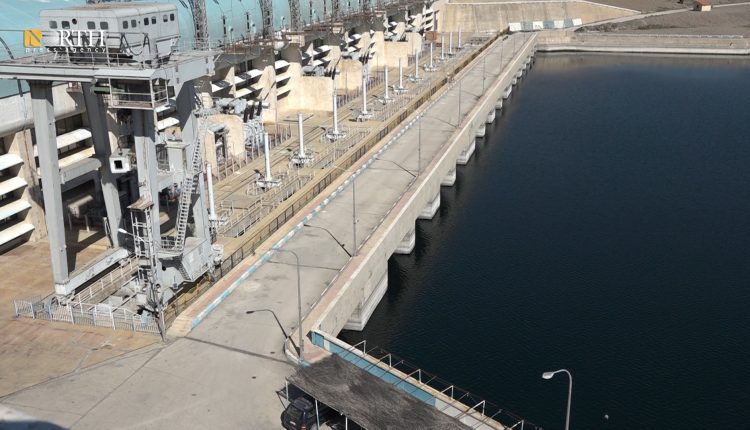Tensions Ease Around Strategic Tishrin Dam as Calls Grow for Lasting Ceasefire
By Kardo Roj
QAMISHLI, Syria (North Press) –
After months of heightened conflict, signs of de-escalation have emerged around the strategic Tishrin Dam in northern Syria, as local actors and international mediators press for a ceasefire to protect critical civilian infrastructure and avert a broader humanitarian crisis.
Located southeast of Manbij on the Euphrates River, Tishrin Dam has been at the center of fierce clashes between the Syrian Democratic Forces (SDF) and Turkish-backed Syrian National Army (SNA) factions since December 2024. The dam, a key provider of electricity and water for hundreds of thousands in northeast Syria, ceased operations last December following significant structural damage caused by military strikes.
Speaking to North Press, Amel Khuzaym, co-chair of the Energy Authority in the Autonomous Administration of North and East Syria (AANES), confirmed that a recent agreement between AANES and the Syrian government aims to demilitarize the dam zone and allow civilian engineers to begin essential repair work.
“Our goal is to ensure water security and safeguard this national asset from further deterioration,” Khuzaym said. “The agreement guarantees unrestricted access for our engineers and allows inspections by independent specialists to assess structural safety.”
U.S.-Backed Efforts to Avert Escalation
The latest developments follow sustained mediation efforts by the United States and the international coalition, which have maintained a stabilizing presence in the region. In December, SDF General Commander Mazloum Abdi announced a temporary truce in Manbij, brokered by U.S. officials, aimed at halting Turkish-backed offensives and laying the groundwork for political dialogue.
While sporadic violations continued in the weeks that followed, particularly around the dam and nearby Karakozak Bridge, coalition forces have since expanded their presence along the Euphrates River to deter further attacks. AANES officials credit the coalition’s role in facilitating relative calm, though tensions remain high.
Elham Ahmad, co-chair of the AANES Foreign Relations Department, told North Press this week that Washington’s involvement has been “instrumental in creating space for dialogue.”
“We welcome all efforts that contribute to a permanent ceasefire and a broader political resolution,” Ahmad said, stressing the need to shield vital infrastructure from military targeting.
A Strategic and Symbolic Battleground
Built in 1999, Tishrin Dam is Syria’s second-largest hydropower facility after the Euphrates Dam. It supplies electricity to large swathes of Aleppo, Raqqa, and Hasakah provinces and irrigates tens of thousands of hectares of farmland. Its significance transcends basic services; control of the dam equates to influence over the region’s energy grid, agricultural viability, and military logistics.
During the past decade of war, the dam has shifted hands multiple times, from Syrian government forces to the Islamic State (ISIS), before its eventual liberation by SDF units in 2015, backed by coalition air support. Since then, it has been under the joint civilian-military administration of the AANES, which has invested in maintaining operations despite resource constraints.
Security analysts say that targeting such infrastructure reflects a broader tactic employed in contested regions where water and power supplies are weaponized for leverage. Recent reports from organizations such as Human Rights Watch have documented recurring attacks on civilian sites by all parties, but particularly underscore the risk posed by continued Turkish drone activity near populated areas.
Civilian Toll and International Warnings
According to the AANES, over 400,000 residents in Manbij and Kobani have faced electricity and water shortages since the dam went offline. The International Committee of the Red Cross has warned that further degradation of the dam could trigger environmental and humanitarian disasters.
In January, hundreds of civilians staged peaceful sit-ins along the dam’s perimeter, demanding its protection and denouncing the targeting of water resources. Drone footage shared by activists showed Turkish UAVs flying overhead as demonstrators held banners urging a ceasefire and international monitoring.
While the relative calm offers a window for reconstruction and diplomacy, local leaders stress that any lasting solution must address the broader political dynamics driving the conflict. The SDF, as the primary local force combating extremist remnants and maintaining internal security, continues to play a central role in these efforts.
Negotiations are reportedly underway for a potential demilitarized zone around Tishrin Dam and other key infrastructure, under joint observation by coalition forces and neutral engineers.
Experts caution that while short-term ceasefires may hold, a durable peace requires international guarantees and meaningful inclusion of local authorities in any future settlement. As the region balances on a fragile edge, the fate of Tishrin Dam remains emblematic of Syria’s complex path toward stability.

